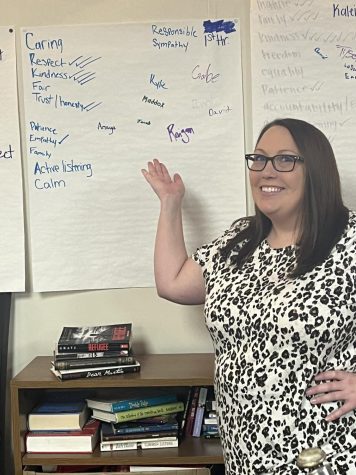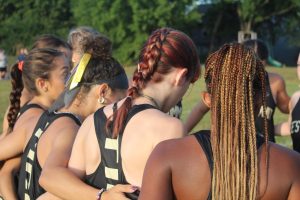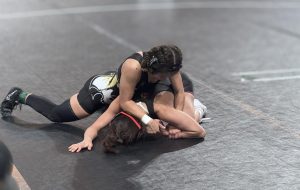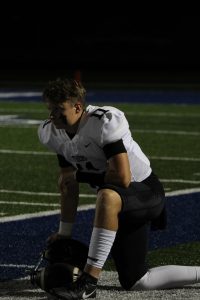On Capturing Success
All the important aspect about Capturing Kids Hearts from the perspective of teachers.
Art teacher Jaclyn Cribb by the social contracts her classes have made as part of Capturing Kids’ Hearts.
October 6, 2023
Teachers Amber Secrist, Katie Hobbs, Jaclyn Cribb, Vickie Metzler and assistant principal James Oyler explain the details of Capturing Kids’ Hearts also known as CKH, and the impact of it on our school.
Each teacher had a different take on what Capturing Kids’ hearts was for them. Oyler explains it as an opportunity to treat everyone with respect.
“Capturing Kids’ hearts is a way for everybody to treat others with dignity and respect in a common way,” Oyler said.
For Metzler, CKH is all about treating everyone as a human being first.
“It’s the idea that before we can even start instructing kids, we have to see them as a human first,” Metzler said.
Cribb’s take on CKH was that it is not just an accountability structure, but also a philosophy.
“It values the student as a whole person, kind of all aspects of them both in school and out of school. It helps cultivate real relationships in the classroom between the teacher and students, which is super important, as well as between students and not just teacher and student but peers as well,” Cribb said.
The most common answer as to why the school implemented CKH was because we needed a more positive environment in the classroom, and a lack of respect between teachers and students, and students and students.
“It seemed like when our students came back from our COVID experience, it wasn’t so much that they were lagging in academic skills, it was more that they were lagging in, this is how we behave around people,” Metzler said.
Hobbs also points out that not just students were struggling but teachers were too.
“I know that many teachers were dissatisfied with the support they were receiving and student problems/concerns were at an all-time high,” Hobbs said.
Teachers were required to attend a training session regarding CKH either over the summer or at the beginning of the school year. Although some teachers were skeptical, other teachers were intrigued or excited to have the opportunity to improve the atmosphere of the school.
“I was curious. I mean, I was ready because last year was a tough year for me, so I was ready for some solutions, some ideas of things that would work. So I was curious, intrigued,” Metzler said.
“I was pretty excited about the training honestly. I came from a district– I mean we were having the same issues– it’s a nationwide issue like we were having the same issues with just building relationships with COVID and everything going on we were virtual, you know made it difficult. So for me when I came here, and I heard about this program, it was new, it was different,” Secrist said.
According to Secrist, Metzler and Cribb, the key to successfully implementing CKH in the classroom is to make it your own.
“I think for me it keeps me intentional in my classroom with my students,” Cribb said.
Another tool that is used a lot in the classroom by some teachers is the social contract.
“I really use the social contract when students aren’t doing what they are supposed to. I feel like it’s just easy to ask simple questions about their own personal behavior and making them take ownership, allowing them to take ownership,” Secrist said.

Each interviewee has had different responses to whether or not CKH has improved the overall atmosphere of the school.
“I think in some ways it has helped student issues, but I do feel that some teachers are still very unhappy with not feeling supported, valued, or respected. I do think there is some value to the CKH program,” Hobbs said.
For Metzler, she has found that CKH has allowed her to have a stronger connection with students.
“I can’t say that I’m doing everything that they taught us to do at the training, but I’ve tried to make it my own, it’s really heightened my awareness that I need to get to know my students, let my students get to know me, and just kind of appreciate one another as human beings first, and then hopefully that instructional piece is a little bit easier then to transition into,” Metzler said.
Even though CKH is meant for the classroom, teachers use it outside of school as well.
“You start looking at more of the positive side even if it’s something more negative. You know I catch myself doing that more anywhere,” Oyler said.
Not everything about CKH is perfect. Seeing that this is everyone’s first year implementing the program, teachers had a few things to say about what they would like to change if they had the chance.
“I think I might just reemphasize that the tools we get to use in Capturing Kids’ Hearts are simply tools, and the most important thing is your relationships with students,” Cribb said.







